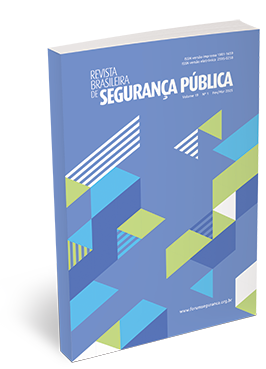EFFECTS OF SEAT BELT USE IN POLICE VEHICLES ON POLICE RESPONSE TIMES IN AMBUSH CASES
A study using single-case experimental design
DOI:
https://doi.org/10.31060/rbsp.2025.v19.n1.1932Keywords:
Police, Safety belt, Seatbelt, Gunfight, Firearms, TacticsAbstract
This study aimed to investigate the influence of safety belt use during police patrolling on the times for exiting the vehicle and returning fire in case of shots fired from the side of the police car. An experiment was taken involving four cadets from a southern Brazilian state police department. Gender, height, weight and BMI were controlled for. All participants were right-handed. Experimenters controlled for 21 potential confusion variables. A single case experimental design was used, with single baselines and between-subjects replication. Time for exiting the police vehicle and time for returning fire were registered. Three conditions have been tested: safety belt on, safety belt off and a hybrid/middleground condition. Results suggest that the use of safety belts raised the time to return fire by individual averages of 0,75s to 0,99s (25% to 33%). In a real situation, those officers could be hit by 2-8 extra shots, due to such a time difference. It wasn’t possible to establish a clear and stable baseline for the hybrid condition (condition 3). Despite that, results suggest condition 3 doesn’t have the potential to present better results than any of the other two conditions. Considering traffic accidents are more likely to victimize police officers than shootings, a cautious risk analysis is required before setting policies on the use of safety belts in police vehicles.
Downloads
References
ANDERSON, Gregory; NOTA, Paula; METZ, Gerlinde; ANDERSEN, Judith. The Impact of acute stress physiology on skilled motor performance: implications for policing. Frontiers in Psychology, v. 10, 2019. AUGUSTSSON, Sofia Ryman; BERSÅS, Ellen; THOMAS, Elin Magnusson; SAHLBERG, Margareta. Gender differences and reliability of selected physical performance tests in young women and men. Advances in Physiotherapy, v. 11, n. 2, p. 64-70, 2009. DOI: https://doi.org/10.1080/14038190801999679
BRASIL. Lei No 9.503, de 23 de setembro de 1997. Institui o Código de Trânsito Brasileiro. Brasília/DF: Diário Oficial da União, Seção 1, ano 135, n. 184, 1997.
FORTES, Marcos de Sá Rego; MARSON, Runer Augusto; MARTINEZ, Eduardo Camilo. Comparação de desempenho físico entre homens e mulheres: revisão de literatura. Revista Mineira de Educação Física, Viçosa, v. 23, n. 2, p. 54-69, 2015.
FUSTER, Vicente; JEREZ, Andrés Santiago; ORTEGA, Ana. Anthropometry and strength relationship: male-female differences. Anthropologischer Anzeiger, v. 56, n. 1, p. 49-56, 1998. DOI: https://doi.org/10.1127/anthranz/56/1998/49
GIESSING, Laura; FRENKEL, Marie Ottilie; ZINNER, Christoph; RUMMEL, Jan; NIEUWENHUYS, Arne; KASPERK, Christian; BRUNE, Maik; ENGEL, Florian Azad; PLESSNER, Henning. Effects of coping-related traits and psychophysiological stress responses on police recruits’ shooting behavior in reality-based scenarios. Frontiers in Psychology, v. 10, 2019. DOI: https://doi.org/10.3389/fpsyg.2019.01523
GRASLEY, Connie; AYOUB, Mahmoud; BETHEA, Nancy. J. Male-Female differences in variables affecting performance. Proceedings of the Human Factors and Ergonomics Society Annual Meeting, v. 22, n. 1, p. 416-420, 1978. DOI: https://doi.org/10.1177/1071181378022001111
IVERSEN, Iver. Single Case Research Methods: An Overview. In: MADDEN, Gregory Jude; DUBE, William; HACKENBERG, Timothy; HANLEY, Gregory; LATTAL, Kennon (Eds.). APA Handbook of Behavior Analysis. Volume 1: Methods and principles. Washington, D.C.: American Psychological Association, 2016, p. 3-32.
JEHLE, Dietrich von Kuenssberg; WAGNER, David; MAYROSE, James; HASHMI, Usman. Seat belt use by police: should they click it?. The Journal of Trauma, v. 58, n. 1, p 119-120, 2005. DOI: https://doi.org/10.1097/01.TA.0000105887.89467.E5
LA TOURRETTE, Tom. Risk factors for injury in law enforcement officer vehicle crashes. Policing: An International Journal, v. 38, n. 3, p. 478-504, 2015. DOI: https://doi.org/10.1108/PIJPSM-03-2015-0027
LEWINSKI, William; HUDSON, William; DYSTERHEFTT, Jennifer. Police officer reaction time to start and stop shooting : the influence of decision-making and pattern recognition. Law Enforcement Executive Forum, v. 14, n. 2, p. 1-16, 2014.
LIMEIRA, Marcio Luiz da Costa; DONATO, Roberto dos Santos. Análise dos acidentes de trânsito com morte de policial militar em serviço na Brigada Militar – de 2006 a 2016. Produto & Produção, Porto Alegre, v. 19, n. 3, 6 set. 2019. DOI: https://doi.org/10.22456/1983-8026.85905
MERINO, Paulo Sérgio. Mortalidade em efetivos da polícia militar do Estado de São Paulo. 2010. 120 f. Dissertação (Mestrado em Saúde Coletiva) – Universidade Federal de São Paulo (Unifesp), São Paulo, 2010.
NHTSA – National Highway Traffic Safety Administration. Occupant fatalities in law enforcement vehicles involved in motor vehicle traffic crashes. Washington, 2018.
NIEUWENHUYS, Arne; OUDEJANS, Raoul. Effects of anxiety on handgun shooting behavior of police officers: a pilot study. Anxiety, Stress & Coping, v. 23, n. 2, p. 225-233, 2010. DOI: https://doi.org/10.1080/10615800902977494
NIEUWENHUYS, Arne; CALJOUW, Simone; LEIJSEN, Maaike; SCHMEITS, Bart; OUDEJANS, Raoul. Quantifying police officers’ arrest and self-defence skills: does performance decrease under pressure?. Ergonomics, v. 52, n. 12, p. 1460-1468, 2009. DOI: https://doi.org/10.1080/00140130903287981
NIEUWENHUYS, Aarne; CAÑAL-BRULAND, Rouwen; OUDEJANS, Raoul. Effects of threat on police officers’ shooting behavior: anxiety, action specificity, and affective influences on perception. Applied Cognitive Psychology, v. 26, n. 4, p. 608-615, 2012. DOI: https://doi.org/10.1002/acp.2838
NIEUWENHUYS, Arne; SAVELSBERGH, Geert; OUDEJANS, Raoul. Shoot or don’t shoot? Why police officers are more inclined to shoot when they are anxious. Emotion, v. 12, n. 4, p. 827-833, 2012. DOI: https://doi.org/10.1037/a0025699
SALLES, Belmiro Freitas de; SIMÃO, Roberto; MIRANDA, Fabrício; NOVAES, Jefferson da Silva; LEMOS, Adriana; WILLARDSON, Jeffrey. Rest interval between sets in strength training. Sports medicine, Auckland, v. 39, n. 9, p. 765-777, 2009. DOI: https://doi.org/10.2165/11315230-000000000-00000
SCHRAM, Ben; ORR, Robin; HINTON, Ben; NORRIS, Geoff; POPE, Rodney. The effects of body armour on mobility and postural control of police officers. Journal of Bodywork and Movement Therapies, v. 24, n. 3, p. 190-194, 2020. DOI: https://doi.org/10.1016/j.jbmt.2020.03.001
SIDMAN, Murray. Tactics of Scientific Research. Evaluating experimental data in Psychology. Michigan: Basic Books, 1960.
SILVA, Jaques Jonas Santos; OLIVEIRA, Paulo Silva de; FERNANDES, Lucio Araújo. Treinamento de condução veicular policial: um estudo de caso na polícia rodoviária federal. Revista Brasileira de Segurança Pública, São Paulo, v. 17, n. 2, p. 394-428, 2023. DOI: https://doi.org/10.31060/rbsp.2023.v17.n2.1599
TATE, Robyn; PERDICES, Michael; ROSENKOETTER, Ulrike; SHADISH, William; VOHRA, Sunita; BARLOW, David; HORNER, Robert; KAZDIN, Alan; KRATOCHWILL, Thomas; MCDONALD, Skye; SAMPSON, Margaret; SHAMSEER, Larissa; TOGHER, Leanne; ALBIN, Richard; BACKMAN, Catherine; DOUGLAS, Jacinta; EVANS, Jonathan; GAST, David; MANOLOV, Rumen; MITCHELL, Geoffrey; NICKELS, Lyndsey; NIKLES,
Jane; OWNSWORTH, Tamara; ROSE, Miranda; SCHMID, Christopher; WILSON, Barbara. The Single-Case Reporting Guideline in Behavioural Interventions (SCRIBE) 2016 Statement. Physical Therapy, v. 96, n. 7, p. 1-10, 2016.
THOMAS, Jerry; NELSON, Jack; SILVERMAN, Stephen. Métodos de Pesquisa em Atividade Física. 6 ed. São Paulo: Artmed, 2012.
TIESMAN, Hope; GWILLIAM, Melody; ROJEK, Jeff; HENDRICKS, Scott; MONTGOMERY, Brian; ALPERT, Geoff. The impact of a crash prevention program in a large law enforcement agency. American Journal of Industrial Medicine, v. 62, n. 10, p. 847-858, 2019. DOI: https://doi.org/10.1002/ajim.23032
Downloads
Published
How to Cite
Issue
Section
License
Copyright (c) 2025 Revista Brasileira de Segurança Pública

This work is licensed under a Creative Commons Attribution 4.0 International License.
Licensing
The Brazilian Journal of Public Security uses the Creative Commons License as a form of licensing for its published works. The license used follows the CC BY 4.0 - Attribution 4.0 International model.
To see the permitted rights please go to the full licence or to our Copyright and Licensing page.



